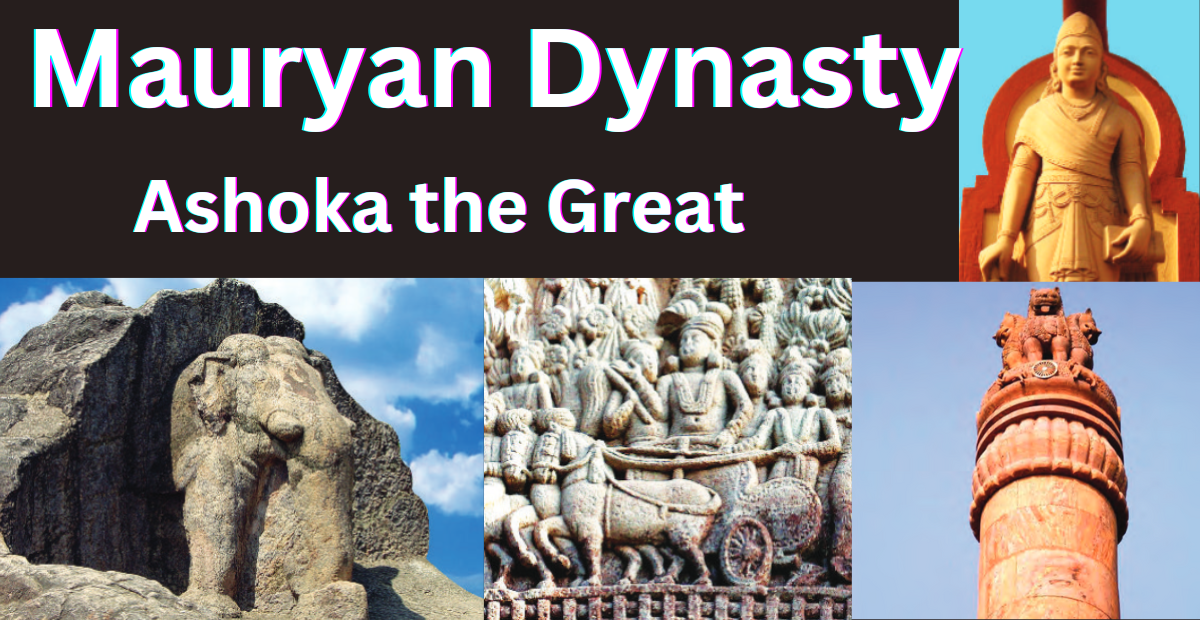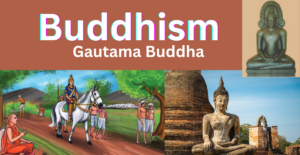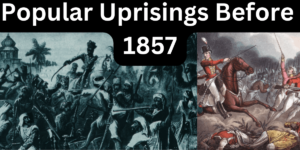Mauryan Dynasty
Introduction to the Mauryan Dynasty:
Contemporary Greek writers have written that Samudragupta was a young man who lived in Taxila when Alexander invaded India.Historians have referred to his name as “Santracotrus“ and “Sandracopus“.With the advice of Chanakya, Samudragupta defeated Nandagala.b. He established the Mauryan Dynasty in 321 B.C.He sat down as its first emperor.
Chandragupta Maurya came to power:
Born in Pataliputra in 340 C.E, Chandragupta allied with Chanakya to bring down the Nanda dynasty.Chanakya or Kautilya, also known as Vishnugupta, was a Brahmin. Out of his enmity towards the Nandas, he devised plans to bring down the Nandas.Intelligence and military power led to the establishment of the Mauryan Dynasty.Chandragupta’s forces defeated the Nandas and captured Magadha and its neighbours.Pataliputra is the capital city and is situated on the banks of river Ganga.The city played an important role in trade, administration and administration.
Reign of Chandragupta Maurya:
Chanakya wrote the famous book ‘Arthashastra’ on political administration.The tantras and strategies about samudra Buddha are the theme of the play ‘Rudraksha’.Centralized administration, efficient bureaucracy and proper revenue collection.After Alexander’s death, the Greek general Seleucus, whom Alexander left behind, established the kingdom as far as the Punjab.Some time before 301 C.E, Samudragupta waged war on him and drove him out of the Punjab.In the end, the two reached an agreement. Accordingly, Samudragupta gave Seleucus 500 war elephants.Instead Seleucus sent his messenger Megasthenes to samudragupta’s court.Most of the information about Samudragupta is contained in megasthenes ‘ in the indica.
Bindusara: (297-273 B.C.E):
Bindusara, the son of Chandragupta, succeeded him.b.He ascended the throne in 297 B.C.EI don’t know what became of samudra Buddha. Some Jain texts show that Chandragupta lived as a monk at Chandragiri near Saravanabela Kolaviya in Karnataka.Bindusara extended the Mauryan influence as far as the Deccan.Diplomatic efforts and military campaigns strengthened the southern borders of the empire.After bindusara ruled for 25 years B.C.E He must have died in 272.
Ashoka the Great:
Ashoka bindusara was not an elected king. He ascended the throne four years after bindusara’s death. Bindusara crowned his son Sumiban.It is said that bindusaras had 100 sons and asoka brothers killed 99 and ascended the throne.Only two names of Ashoka, Devanan Priyar and Priyadarshini, are mentioned in all the inscriptions.Ashoka is mentioned in an inscription called ‘Maski‘.The terrible Battle of Kalinga in 261C . deeply affected Ashoka.The suffering of the people of Kalinga brought about a change in Ashoka’s policies.Conversion to Buddhism and promoting dharma:Ashoka embraced Buddhism, renounced violence and fostered peace.
He promoted dharma (righteousness) through inscriptions and rock orders throughout the empire.Governors administer the provinces and maintain law and order.The local authorities handled the daily administration and revenue collection.A well-organized army with infantry, cavalry and war elephants.Successful military campaigns expanded the boundaries of the Mauryan Dynasty.
Inscriptions of Ashoka :
There are 33 inscriptions on Ashoka.
- Major rocks -14
- Minor rocks-2
- Pillar Inscription -7
- Cave Inscription
- Queen Inscription
- Other Inscriptions
Pillar inscription:
- 242 BCE and later, it was inscribed following his embrace of the Dhamma.
- Found at 10 locations across India and Nepal, often referring to pilgrimage sites or important trade routes.
- Primarily in Prakrit, with a few exceptions, such as the Greek inscriptions in Delhi and Dobra.
Dobra Pillar Charter:
The only major pillar left in full form is the detailed instructions for the authorities and the emphasis on ahimsa.
Lumbini Pillar Inscription:
It refers to the birthplace of Buddha and proclaims Ashoka’s pilgrimage and commitment to the Dhamma.
Cave inscriptions:
Inscribed at different stages of Ashoka’s reign, approximately from 258 BC to 242 BC .It is found in many caves across India, including Barabar Hills, Bhaja Hills, Karla Caves and so on.Primarily in Prakrit, with some inscriptions in the Brahmi script.
- Barabar Caves: These inscriptions highlight the early religious tolerance of Ashoka and have dedicated various caves to the Ajeevikas, a sect of monk practitioners.
- Bhaja Caves: The inscriptions here refer to dharma, moral conduct and respect for all religions, expressing the broad message of Ashoka.
- Karla Caves: This inscription praises the dedication of a cave to the Buddhist Sangha, which proves Ashoka’s support for the faith.
Queen Inscription :
An inscription called the “Queen’s Order” is mentioned in various sources.However, it is not actually a separate inscription, but rather a specific subsection within the Allahabad-Kosam Pillar Act (also known as The Minor Rock Edit VII).This section focuses on instructions on ethical conduct, religious tolerance and respect for adults for women, especially for women in the royal family.While the right to write has not been explicitly stated for any particular queen, some scholars believe that it reflects Ashoka’s guidance to his female relatives or a woman officer in high office.
Inscription No. | location | language | Main Themes |
I | Dhauli & Girnar | Prakrit | Animal Welfare, Non-Violence |
II | Dhauli & Girnar | Prakrit | Care for humans and animals, recipients: The Kingdoms of South India and the Greek king Antiochus II |
III | Dhauli & Girnar | Prakrit | The spread of generosity and the principle of dharma to the Brahmins |
IV | Dhauli & Girnar | Prakrit | Dhammakosa vs. Pericosa, The Impact of Dharma on Society |
V | Dhauli & Girnar | Prakrit | Policy on slaves, “Every man is my child”, appointment of Dhammagamatra |
VI | Dhauli & Girnar | Prakrit | The king’s desire for information on the conditions of the people and welfare schemes |
VII | Dhauli & Girnar | Prakrit | religious tolerance, “insulting others can be harmful to one’s own sect” |
VIII | Dhauli | Prakrit | Ashoka’s first dharma yatra to Bodhgaya and Bodhi tree |
IX | Girnar | Prakrit | Condemning people’s festivals, importance of dharma festivals |
X | Peshawar | Gandhari | Condemnation of the desire for fame and fame, emphasis on dharma fame |
XI | Kandahar | Aramaic | Description of Dharma Major |
XII | Taxila & Shahbazgarhi | Greek | A guided and firm demand for religious tolerance |
XIII | Muskey & Girnar | Prakrit | Kalinga War, Dharma Development, Animal Welfare, The Victory of Dharma in South India and Sri Lanka |
XIV | All Locations | Prakrit | Carving of inscriptions throughout the country |
Administration of Mauryan Dynasty:
The province-districtà àtown village àhad organizations called Kobaca.Greek historians call the Mauryan Empire a centralized state.The Arthashastra elaborates on the administration of the Mauryas.They say the administration needed huge funds. The priest, the army chief and the chief minister were paid Rs 48,000 and the soldiers were paid Rs 500.Only Pataliputra was administered directly. The rest of the areas were divided into four parts, namely, Swarnagiri Ujjaini near Karur in Andhra Pradesh, Andissa Dosali in the south-east of NorthwestErn Thachsheela and ruled by representatives.Generally, there was a rule that the government had to pay one-sixth as tax. One-fourth of the tax was collected.Land tax, government irrigation tax, urban house tax, customs duty on business and entry tax were purchased for revenue.The army is 30,000 cavalry, nine thousand elephants, 3,000 chariots and 6 00,000 soldiers.
- Prokta –possibly with administrative or managerial responsibilities.
- Durgapala– the protector of the fort.
- Kandakosattana –specific administrative role or duty
- Amartya-governance or administration.
- Samaharta – Tax-collecting finance officer.
- Sthanitha – District Administrative Officer.
- Koba – in-charge of five to ten villages.
- Civilization – the responsibility of the cities.
- Gramani – Village Administration.
Mauryan Dynasty Agriculture:
Agriculture was the backbone of the Mauryan Dynasty‘s economy.It was cultivated twice a year, and the Greeks were amazed to see this.Along with food grains, they also cultivated commercial crops such as bajra and cotton, megasthenes noted.
Mauryan Dynasty Handicrafts:
Powerful handicrafts added prosperity to the economy.It can be classified into various categories such as utility goods, luxury goods, and woolen garments.The Arthashastra says that special fabrics were produced in Kasi, Bengal, Kamarupam, Madurai, and many other places.Metalworkers used iron, chamomile and metals to make tools, equipment, utensils, and other household goods.The trees were used to build ships, buildings and cart preparations, building houses and other works.
Mauryan Dynasty Trade:
Trade is the stage of economic decentralization and growth.Transports were set up across north India to carry out business.Roads are connected to the northern parts of the country to the south-east and the cities in the south-western parts of the country through vidisha and Ujjain.They also carried out sea trade with Burma, the Malay Archipelago and Sri Lanka.Entry tax collection centres were set up so that traders could buy entry tax while carrying goods. Woolly silk scented wood, animal skin, gemstones were exported to many places.Dyes, ivory, turtles, pearls, perfumes, and rare logs of wood were exported to Egypt.
Mauryan Dynasty Currency and Money:
Although the Mauryas were familiar with the monetary system, they exchanged through the ancient system in pre-modern economies.The silver coins of the Mauryan Empire were widely used. Printed silver coins have been found in many places in North India.
Mauryan Dynasty Houses and Urban Settings:
Cities were generally set up along rivers. It could have been set up for sea travel and transportation convenience.These were surrounded by trenches and the protective castle walls were also built.Houses built of clay brick or baked brick were formed.There were facilities such as sewers, text wells and clay pits.
Mauryan Dynasty Pataliputra:
Pataliputra is described as the capital of the empire and it is described as having a parallel form of the confluence of the Ganges and the Son river.It was an active city with a length of more than 14 kilometers and just 2 1/2 kilometers wide.The cities had 64 gates and 570 watchtowers.
Third Buddhist Association:
- Some scholarly interpretations hold that the account of the polychronicals of the third Buddhist church, which took place during the reign of Emperor Ashoka in Pataliputra (modern Patna), is different from the second congregation of the Theravada tradition.
- It is said to have occurred in 247 BC.Traditionally it is believed that the focus was on purifying the Sangh (ascetic society) and removing the influences of bigotry.
The Fall of the Mauryan Dynasty :
- Ashoka died in 231 B.C.Although Ashoka’s descendants were weak and capable, the centralized Mauryan administration became unmanageable.Independent autonomous states were created.The Indo-Greek, Sagar and Kushana invasions from the northwest were continuous.
- The Mauryan Empire was divided into two parts.
Eastern Region:
- Dasaratha
- Sump Rish
- Prakaruthan
Western Region :
- Gunalan
- Bakkiyan
Pratika, the last emperor of the Mauryan Empire, was assassinated by his general Pushyamitra Sungana in 185 BCLater Pushya Mitra Sangan founded the Sunga dynasty.





Pingback: Post-Mauryan period |Indo-Greeks |Kushana |Sunga | Satavahanas